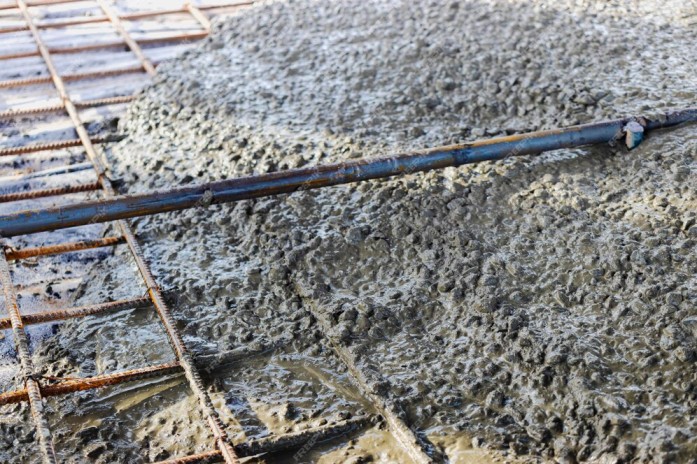Concrete is a combination of such components as cement, sand, aggregates and water added for the concrete work. The proportion of each material determines the workability of concrete, strength and durability of concrete. There are two primary methods to determine how much of each ingredient to use: the nominal mix and the design mix of concrete. Getting the appropriate blend of material and proportion of concrete for a construction makes for a quick and inexpensive construction whether it is a small or large building.
Under this blog, Walls and Dreams discuss all the necessary information one needs to know about concrete mix ratios and types of concrete: basic concrete mix ratios, M25 concrete grade, and concrete mix ratio calculator with the application, characterization of M25 concrete grade and its calculations.
What is the Concrete Mix Ratio?
Proportioning involves the determination of the kind, quality and ratio of the concrete ingredients necessary to yield an easy to transport, place and compact concrete mix that should reach the required strength as and when needed. Remember concrete consists of cement, sand, aggregates and water. In this, cement is an essential ingredient that holds the mix together. Although cement will harden on its own, when mixed with water it forms a paste that holds the other aggregative materials such as sand and coarse aggregates. There are more parameters that have to be taken into account when deciding the proper concrete mix ratio; water cement ratio, fine aggregate to coarse aggregate ratio as well as the requirements for particular admixtures that can be incorporated into the concrete mix.
Types of Concrete Mix Ratios
Concrete mix ratios can be classified into the following categories:
Nominal Mix Concrete: In this mix all the components and the ratio of their quantities are described in terms of standard norms. A specific strength of concrete is determined by these proportions through a cement to aggregates ratio.
Design Mix Concrete: Here, a qualified civil engineer determines the properties of every ingredient in order to determine the proportions for the concrete mix. This is determined from the requirement of strength and quality and a number of admixtures may be employed to achieve a desired property.
What is the M25 Ratio?
M25 is one of the concrete grade which Mix stands for Mix and 25 denotes the compressive crushing strength of concrete cube of size 15cm × 15cm × 15 cm after 28 days of curing in N/mm². More specifically, the concrete is prepared using a ratio known as the M25 concrete ratio which gives the concrete the characteristic compressive strength of 25 N/mm² (or MPa). This shows the extent to which the concrete can be loaded without failure of the material or structure.
Uses of M25 Concrete Mix Ratio
M25 grade concrete is actually used in medium to large stock building structures hence it is applied in every project that involves Reinforced Cement Concrete. Typical applications include:
- Support of earth and massive structure by constructing retaining walls.
- Building columns, slabs, beams for buildings and bridges and other large civil structures.
- Establishing long-lasting surfaces for the pavements intended for dealing with congestion.
What Details are Required to Make the M25 Grade of Concrete?
According to the Indian Standard IS 456:2000, the following input factors necessary for Proportioning M25 grade concrete are:
- Type of cement
- Type of aggregate
- That is the largest size of aggregate in which the mixture can be used in its nominal functional form.
- Minimum cement content
- Maximum water-cement ratio
- Workability
- Exposure conditions
- The concrete mix should not have a maximum temperature of concrete during its placement.
- Method of placement
- Degree of supervision
- Any admixtures that have to be added and the type of admixture along with its usage conditions
Characteristics of M25 Concrete Ratio in Construction
Standardization and Compliance: The M25 concrete ratio meets all the set requirements in the Indian Standard (IS) code in order to enhance quality and safety of constructions.
Structural Integrity: The concrete ratio of M25 is important in aspects such as general building construction. Proper ratio of cement, sand and aggregate makes the concrete capable of carrying necessary load stresses avoiding cracking and maintaining the shape n form as and when required especially in large structure like tall building, bridges and retaining walls etc.
Strength and Durability: All the component ratios in the mix design have a direct bearing on the strength and durability of concrete. The M25 concrete ratio results in concrete with a compressive strength of 25 MPa or N/mm² after 28 curing days making it appropriate for use in several civil construction works and construction projects, which guarantees durability and reliability.
Cost-Effectiveness: It is easier to achieve if the grade of M25 concrete is properly designed so that the usage of the ingredient achieves maximum utilization that results in cheap and efficient utilization of components with minimum wastages. So when the specified ratio is followed the contractors are in a position to know the correct proportion of quantified cement, sand, and aggregates required to be used, thus reducing material wastage and other unnecessary expenses.
Efficient Construction Process: The M25 concrete ratio factor enables efficient construction functioning. A uniform mix design is preferably adopted on site because it minimises difficulties in batch and mix of materials at the site, thus enhances construction processes and aids in meeting project schedule.
How to Calculate M25 Concrete Mix Ratio for 1 Cubic Metre?
Calculate the Targeted Strength: Use the formula:
Calculate the Targeted Strength: Use the formula:
f′ck=fck+1.65sf’ck = fck + 1.65sf′ck=fck+1.65s
Where:
- f′ckf’ckf″ck = mean given target strength of block at 28 days
- fckfckfct = mean value of the modulus of rupture at 28 days
- sss = Standard deviation as per IS Code 456:2000
- 1.65=statistical value arrived at on the acceptable failure fractions/conversion and the number of tests.
- Choose the Water-Cement Ratio: Table number 5 of IS 456:2000 will give the right proportion for preparation of M25-grade concrete by water-cement ratio.
- Determine Cement Content: Estimating the cement content from the volume of water per unit of concrete and water-cement ratio depending on the maximum cement content IS 456:2000.
- Determine the Aggregate Content: In particular, both fine and coarse aggregates are used in some proportion. A 20mm aggregate is standard for construction purposes.
- Calculate the Water Content and the Fine Aggregates-to-Total Aggregate Ratio: To get the right workability, determine the proportion of fine aggregate (sand) to the total aggregate in absolute volume and also the volume of water for the concrete.
Thus one can conclude that knowing the M25 concrete mix ratio will be essential to achieving high strength and long-lived construction works. The relative proportions needed for a mixture that is suitable for both strength and workability of concrete are critical. M25 concrete has a perfect proportion of ingredients, and it can be used in structures and elements, and as retaining walls. Engineering and construction professionals value its important attributes such as, low cost, excellent structural features, high compressive strength and durability. Concrete proportions create accurate mixes and endorse effective and durable buildings, which is why builders should be conversant with concrete characteristics and mix ratios.








